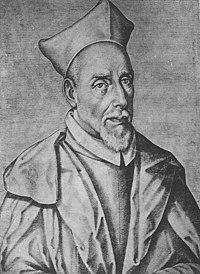music.wikisort.org - Composer
Francisco Guerrero (October 4 (?), 1528 – November 8, 1599) was a Spanish Catholic priest and composer of the Renaissance. He was born and died in Seville.
This article needs additional citations for verification. (January 2017) |

Life and career
Guerrero's early musical education was with his older brother Pedro and after that with the famous composer Cristóbal de Morales. At the age of 18 he was appointed maestro de capilla (i.e. music director) at Jaén Cathedral. Three years later he accepted a position of singer at Seville Cathedral. During this time he was much in demand as a singer and composer, establishing an exceptional reputation before his thirtieth birthday; in addition he published several collections of his music abroad, an unusual event for a young composer.
After several decades of working and traveling throughout Spain and Portugal, sometimes in the employ of emperor Maximilian II, he went to Italy for a year (1581–1582) where he published two books of his music. After returning to Spain for several years, he decided to travel to the Holy Land, which he finally was able to do in 1589. His adventure included visits to Damascus, Bethlehem, and Jerusalem; on the return trip his ship was twice attacked by pirates, who threatened his life, stole his money, and held him for ransom. He was able to return to Spain; unfortunately he had no money, and endured a series of misfortunes, including some time spent in debtors' prison. At last his old employer at Seville Cathedral extricated Guerrero and he resumed working for them. His book on his adventurous visit to the Holy Land was published in 1590 and was a popular success (it is reasonable to suppose that Cervantes knew it). At the end of the decade he planned one more trip to the Holy Land but died in the plague of 1599 in Seville before he was able to depart.
Of all the Spanish Renaissance composers, he lived and worked the most in Spain. Others—for example Morales and Victoria—spent large portions of their careers in Italy (though, unlike many Franco-Flemish composers of the time, Spanish composers usually returned home later in life).
Guerrero's music was both sacred and secular, unlike that of Victoria and Morales, the two other Spanish 16th-century composers of the first rank. He wrote numerous secular songs and instrumental pieces, in addition to masses, motets, and Passions. He was able to capture an astonishing variety of moods in his music, from ecstasy to despair, longing, joy, and devotional stillness; his music remained popular for hundreds of years, especially in cathedrals in Latin America. Stylistically he preferred homophonic textures, rather like his Spanish contemporaries, and he wrote memorable, singable lines. One interesting feature of his style is how he anticipated functional harmonic usage: there is a case of a Magnificat discovered in Lima, Peru, once thought to be an anonymous 18th century work, which turned out to be a work of his.[1]
Recordings
- Francisco Guerrero, Missa Sancta Et Immaculata, Motets, Etc. James O'Donnell, Westminster Cathedral Choir. Helios 55313
- Francisco Guerrero, Missa Super Flumina Babylonis. Michael Noone, Ensemble Plus Ultra. GCD922005
- Francisco Guerrero, Missa Surge Propera. Peter Philips, Tallis Scholars. CDGIM040
- Apollo5, Where All Roses Go, includes Veni Domine,Oh, Virgen, cuando os miro, and Virgen Sancta, VOCES8 Records, UNSPSC Code 55111500
Notes
- Stevenson, Grove, vol. 7 p. 789
References
- Robert Stevenson, "Francisco Guerrero." The New Grove Dictionary of Music and Musicians, ed. Stanley Sadie. 20 vol. London, Macmillan Publishers Ltd., 1980. ISBN 1-56159-174-2
Further reading
- Gustave Reese, Music in the Renaissance. New York, W.W. Norton & Co., 1954. ISBN 0-393-09530-4
- G. Edward Bruner, DMA: "Editions and Analysis of Five Missa Beata Virgine Maria by the Spanish Composers: Morales, Guerrero, Victoria, Vivanco, and Esquivel." DMA diss., University of Illinois at Urbana-Champaign, 1980. Facsimile: University Microfilms International, Ann Arbor, Michigan, USA
External links
- Works by Francisco Guerrero at Project Gutenberg
- Works by or about Francisco Guerrero at Internet Archive
- Free scores by Francisco Guerrero in the Choral Public Domain Library (ChoralWiki)
- Free scores by Francisco Guerrero at the International Music Score Library Project (IMSLP)
- Maestros del Siglo de Oro, Morales, Guerrero, Victoria, La Capella Reial de Catalunya, Hespèrion XX, dir. Jordi Savall, Alia Vox AVSA9867
На других языках
[de] Francisco Guerrero (Komponist)
Francisco Guerrero (* 1527 oder 1528 in Sevilla; † 8. November 1599 ebenda) war, gemeinsam mit Tomás Luis de Victoria und Cristóbal de Morales, einer der bedeutenden spanischen Komponisten geistlicher Musik der Renaissance.- [en] Francisco Guerrero (composer)
[es] Francisco Guerrero
Francisco Guerrero de Burgos (Sevilla, 4 de octubre de 1528-ibídem, 8 de noviembre de 1599) fue un sacerdote católico español y maestro de capilla que junto a Tomás Luis de Victoria y Cristóbal de Morales es uno de los grandes nombres de la música sacra del Renacimiento y uno de los mayores compositores hispanos de todos los tiempos, cuyas obras se difundieron y apreciaron no solo en Europa sino también en los territorios de la Corona Española de la época, especialmente las grandes catedrales americanas como la de Puebla o Cuzco.[ru] Герреро, Франсиско
Франсиско Герре́ро (исп. Francisco Guerrero; 4 октября 1528 (1528-10-04), Севилья — 8 ноября 1599, там же) — испанский композитор ; наряду с Т. Л. де Викторией наиболее значительный автор церковной музыки испанского Ренессанса. Представитель андалусийской школы композиторов XVI века[4][5].Другой контент может иметь иную лицензию. Перед использованием материалов сайта WikiSort.org внимательно изучите правила лицензирования конкретных элементов наполнения сайта.
WikiSort.org - проект по пересортировке и дополнению контента Википедии